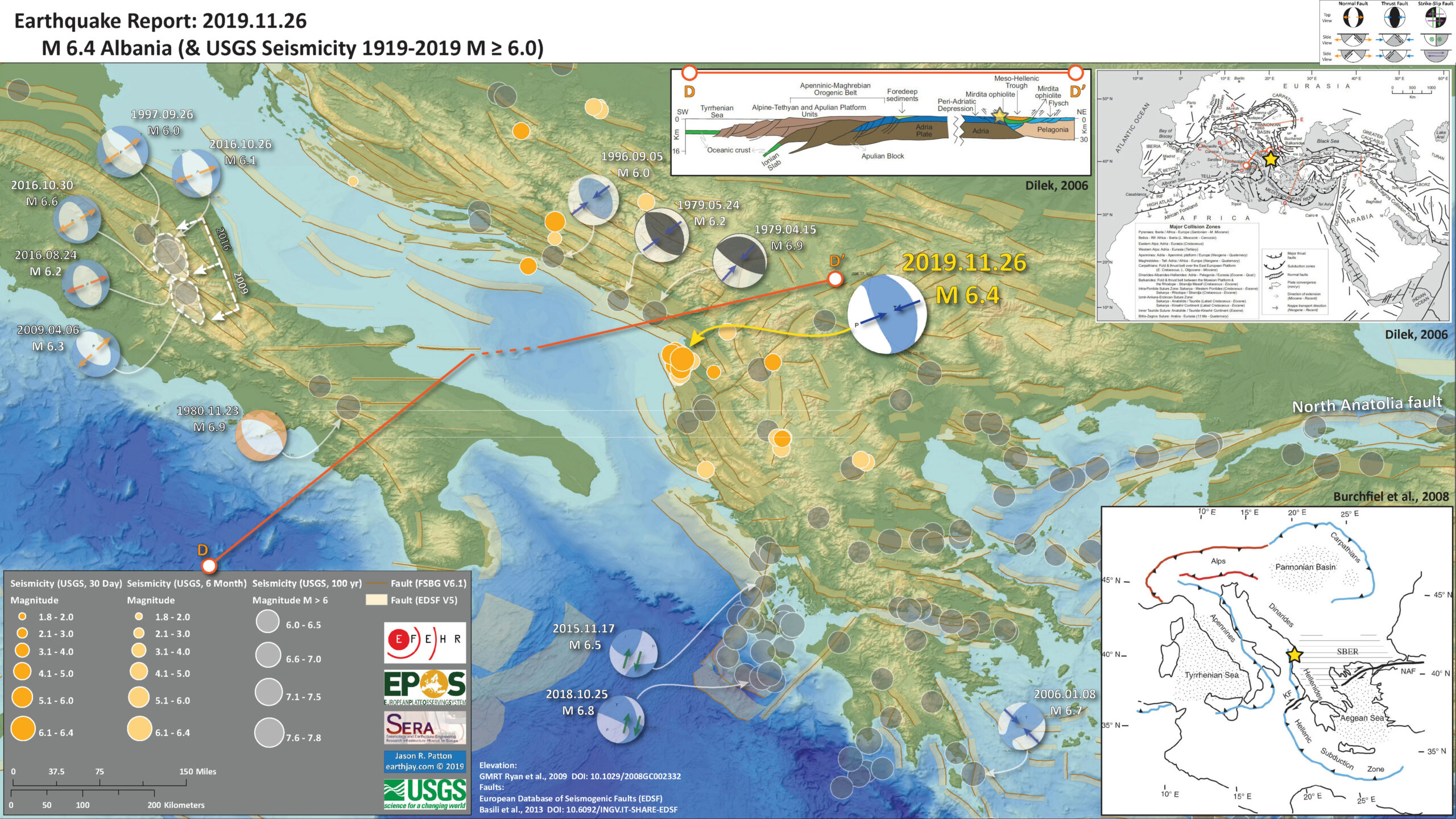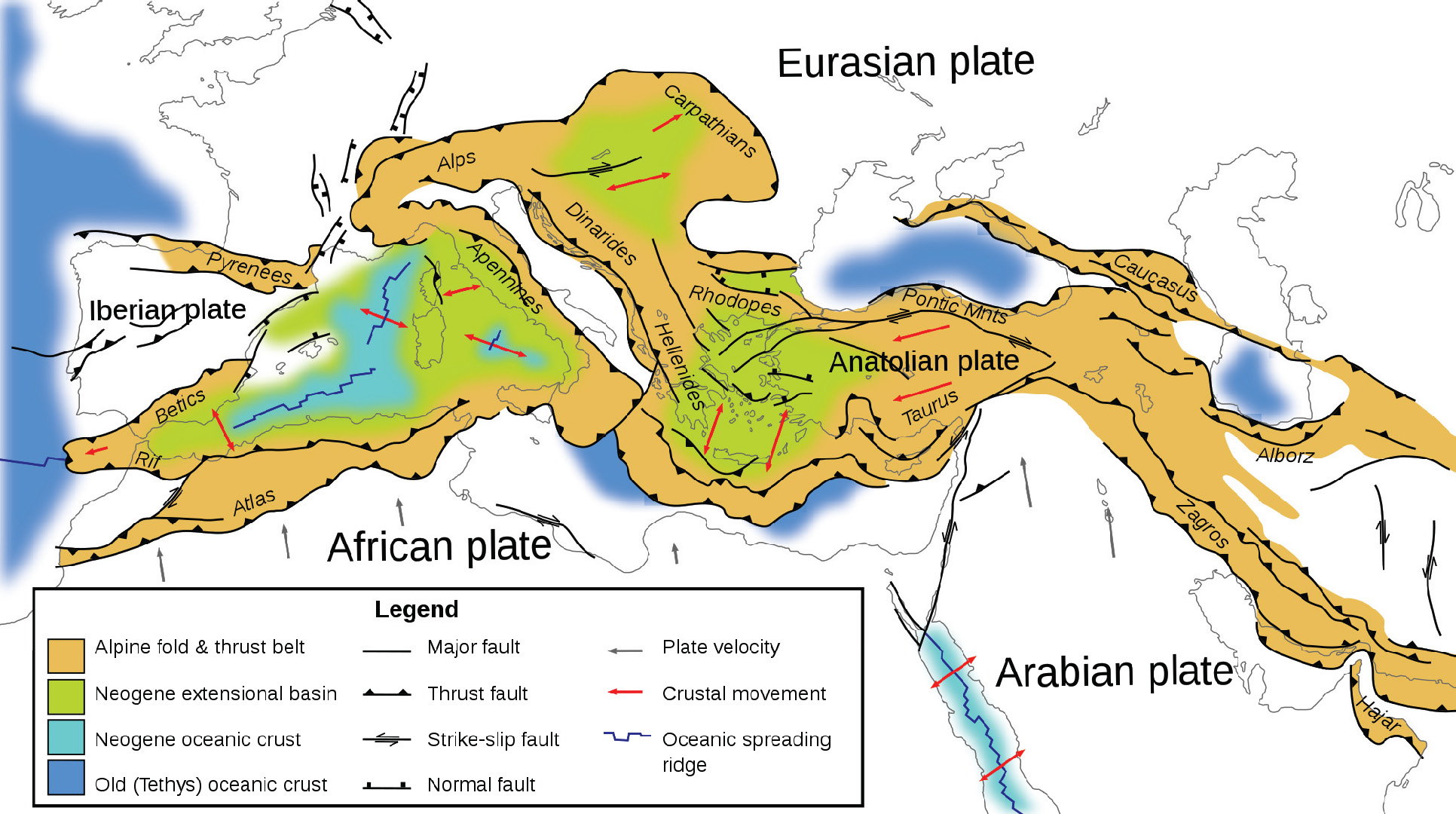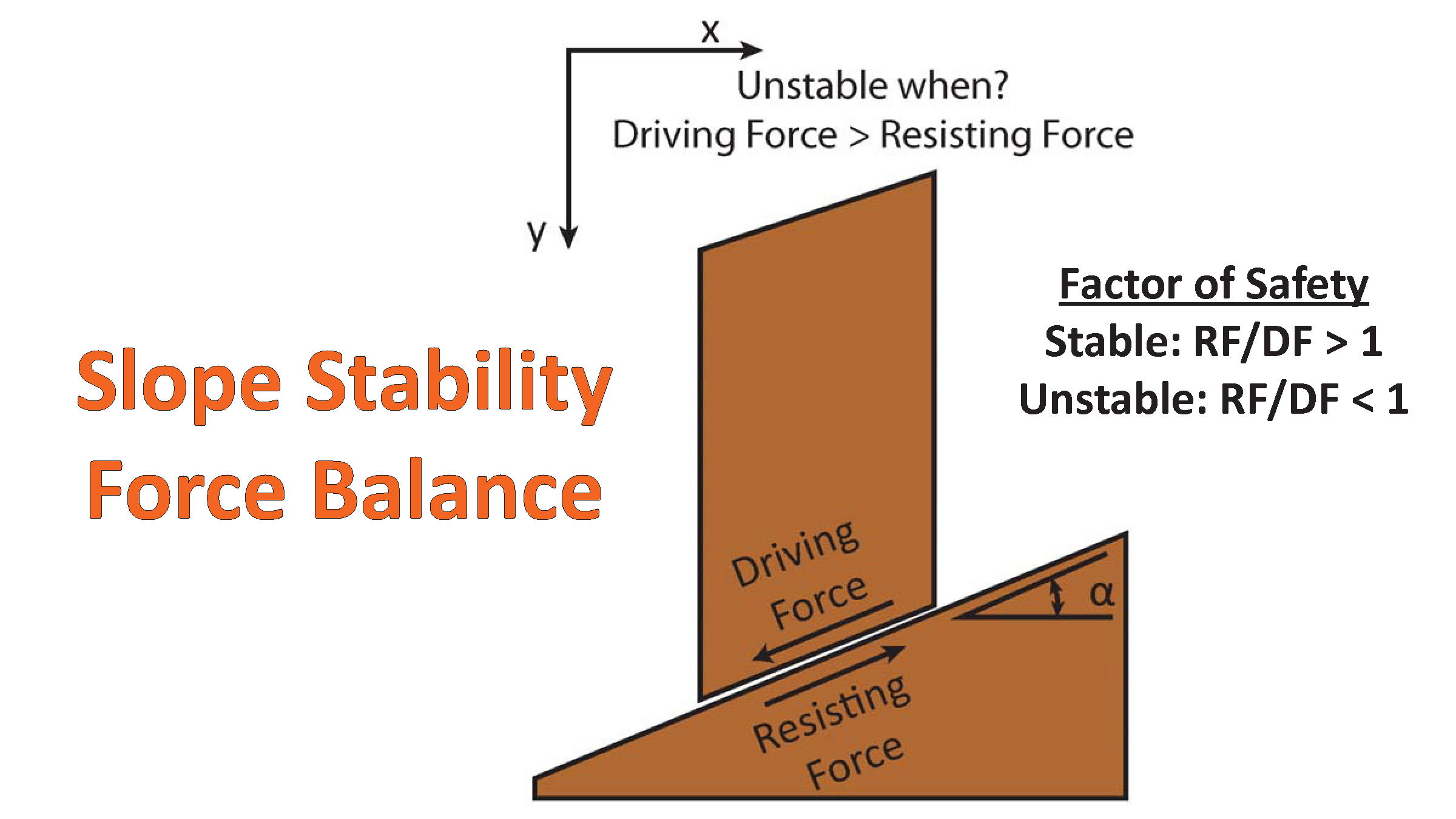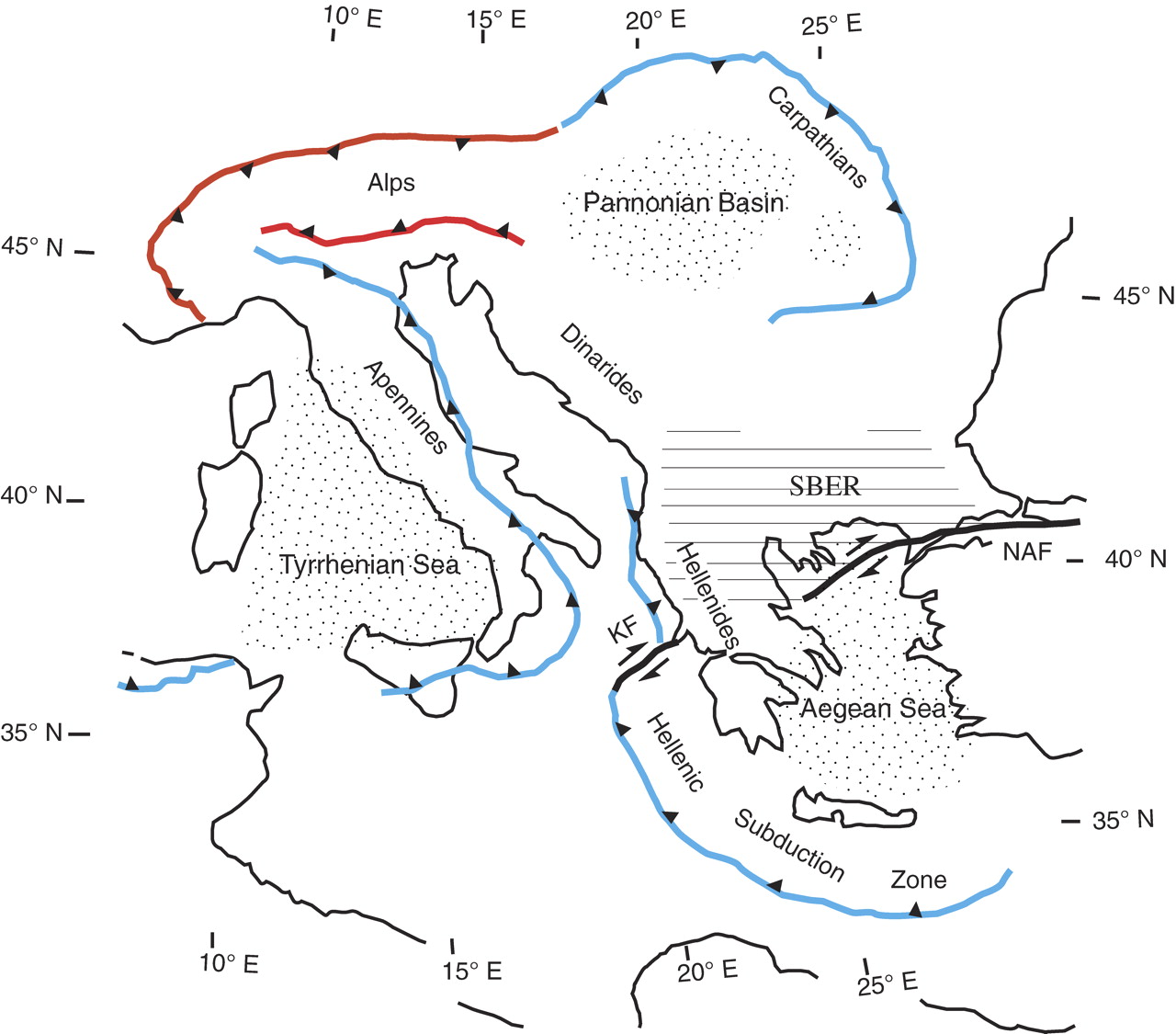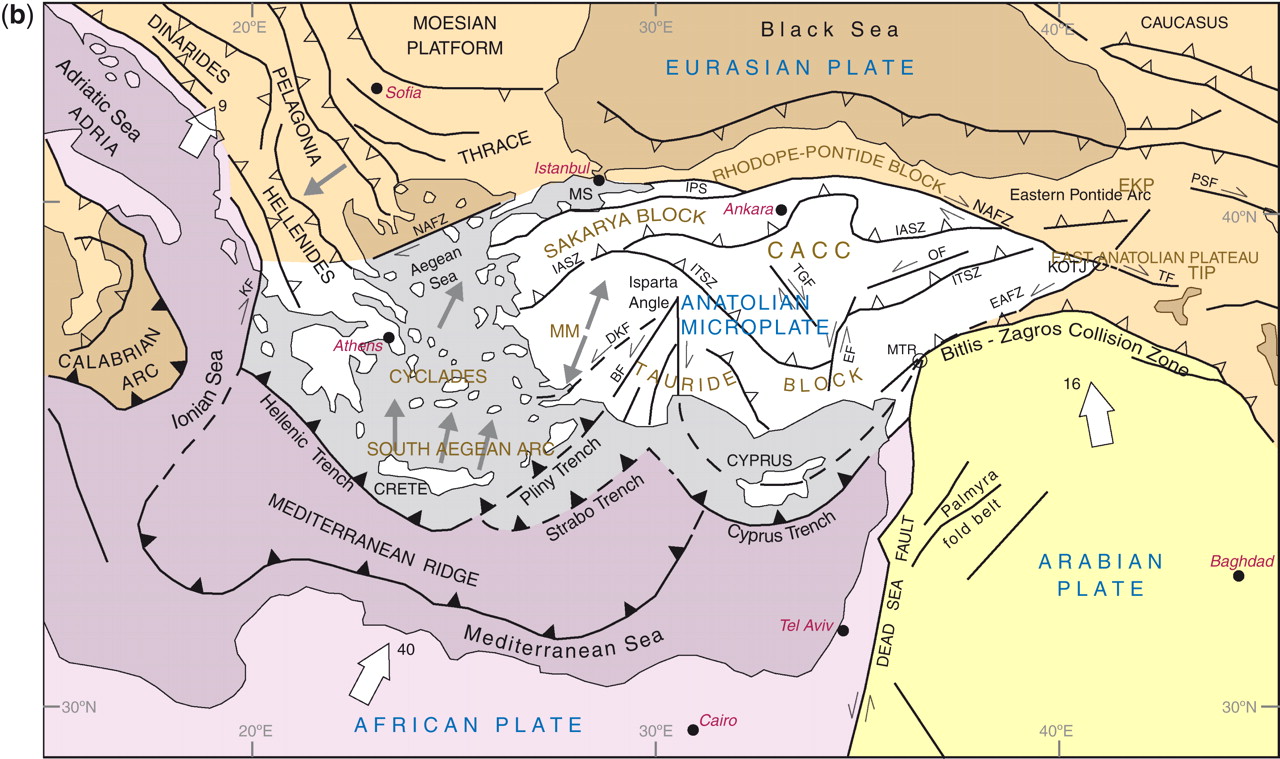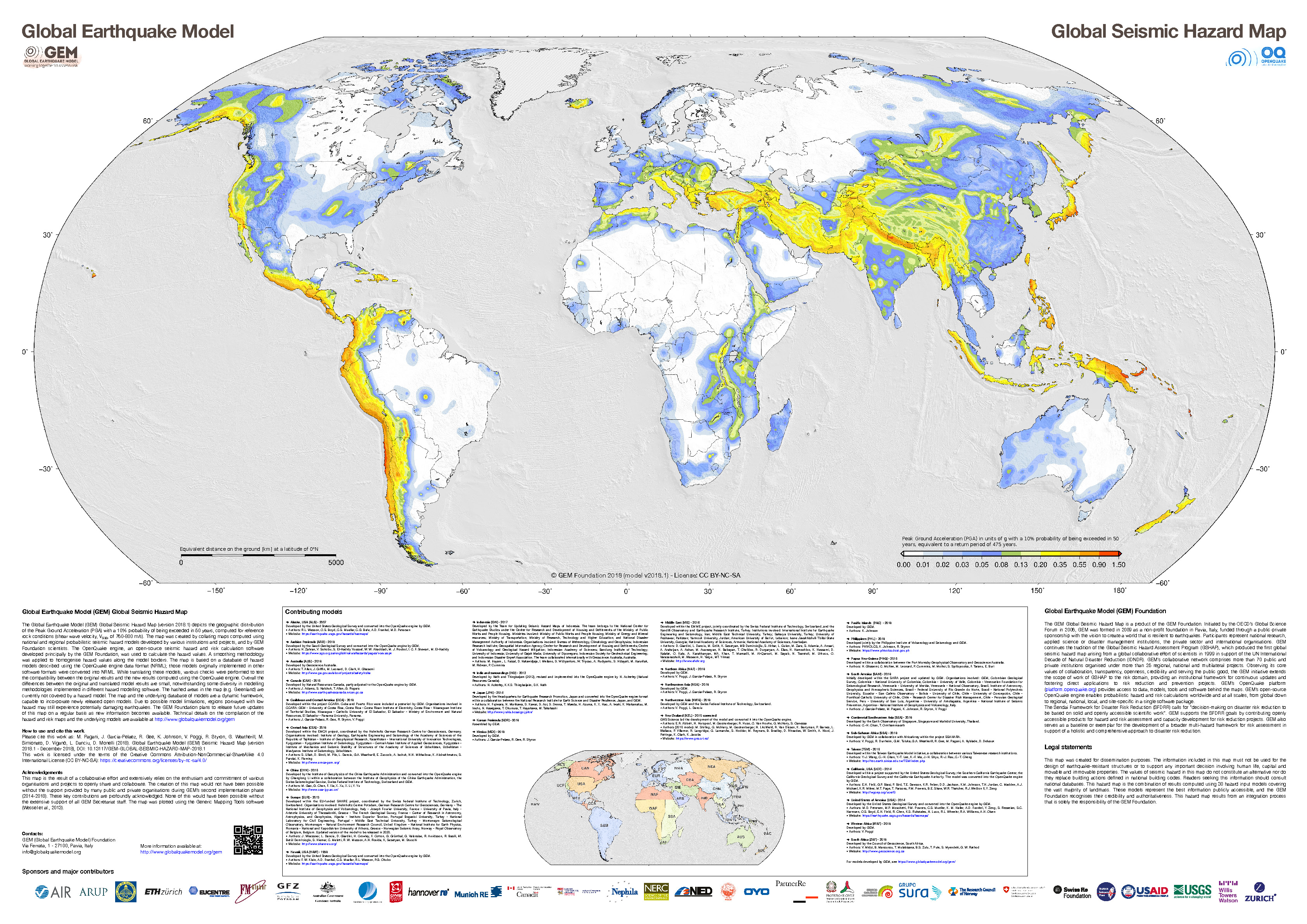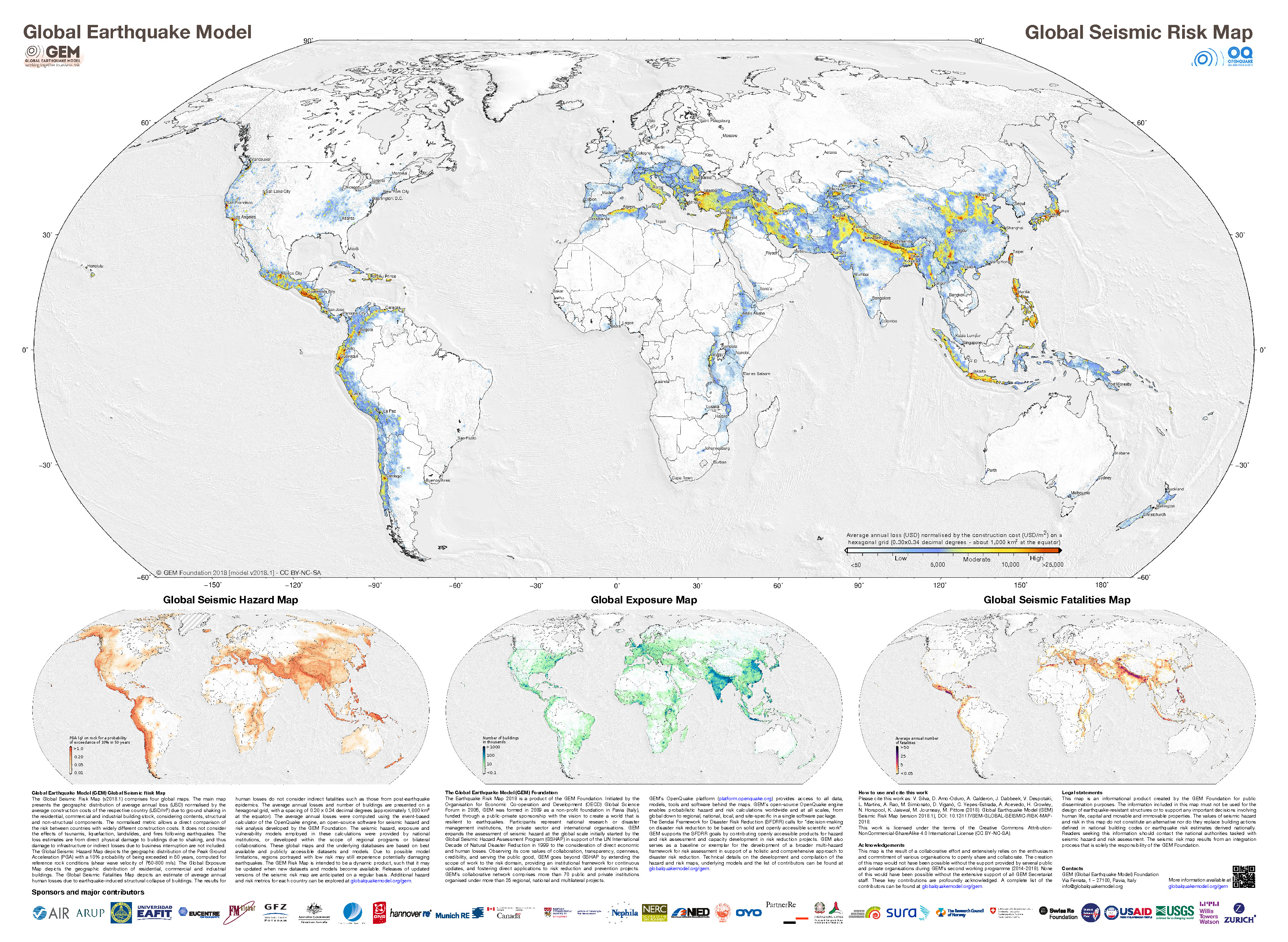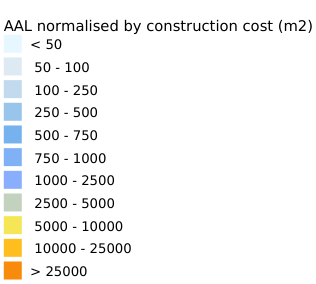A couple days ago there was a deadly earthquake along the coast of Albania near the cities of Durrës and Mamurras. This M 6.4 earthquake caused many deaths and significant damage to buildings.
https://earthquake.usgs.gov/earthquakes/eventpage/us70006d0m/executive
The west coast of Albania is a convergent plate boundary and there is a fold and thrust belt (thrust faults and folds formed due to the compression from plate convergence). Here, the Adria plate is diving beneath the Pelagonia (Eurasia) plate to form the Adriatic collision zone. The convergence here forms the Hellenides mountains. However, much of the tectonics in the region is currently extensional.
This plate boundary system is generally part of the Alpide Belt, a convergent plate boundary that extends from Indonesia/Australia (Sumatra and Java subduction zones), through the Himalayas, through the Middle East (Makran and Zagros thrusts), through the Mediterranean (Greece, Italy), Europe (e.g. the Alps, Carpathians, Pyrenees, etc.), and northern Africa (the Atlas mtns). However, there are lots of microplates and tectonic blocks that slice-and-dice the region with strike-slip faults (like the Dead Sea Fault, the North and East Anatolian faults in Turkey, and the Cephalonia/Kefallonia transform fault in western Greece).
Here is a view of the Alpide Belt as it transects Africa, Europe, and the Middle East (Woudloper, 2009).
There was a sequence of earthquakes in September earlier this year. These are possibly either foreshocks to this November sequence, or they changed the stress in the surrounding crust to trigger the November sequence, or they are unrelated to the November sequence.
The Global Earthquake Model (GEM) program has several data products, including a global fault database and global seismic hazard and risk maps. The fault database is a compilation of many regional and national databases. In the eastern Mediterranean, the GEM faults are from the European Database of Seismogenic Faults (EDSF) and (earlier form) the
Database of Individual Seismogenic Sources (DISS).
There are some candidate faults that we can take a look at as possible sources for both the September and November sequences.
In the past several years, the rapid group-interpretation and dissemination of earthquake and tsunami data (largely via social media platforms) has changed the rate at which we learn about these events. In previous decades, it might take months to years for this information to be collected, processed, and disseminated (via peer review papers). Now, with remote sensing techniques (seismometers, satellite or aerial data, GPS, and tide gages, all of which provide near real time data) and advanced analytical methods bring us these results in days to weeks.
In the days since the earthquake, there have been many of these rapidly developed tectonic realizations. Take a look at the social media posts at the bottom of this report for some examples of this.
Below is my interpretive poster for this earthquake
- I plot the seismicity from the past month, half year, and century, with diameter representing magnitude (see legend). I include earthquake epicenters from 1919-2019 with magnitudes M ≥ 6.0.
- I plot the USGS fault plane solutions (moment tensors in blue and focal mechanisms in orange), possibly in addition to some relevant historic earthquakes.
- A review of the basic base map variations and data that I use for the interpretive posters can be found on the Earthquake Reports page.
- Some basic fundamentals of earthquake geology and plate tectonics can be found on the Earthquake Plate Tectonic Fundamentals page.
- In the lower right corner is a generalized tectonic fault map from Burchfiel et al. (2008). convergent plate boundary faults are shown with triangle symbols and red or blue lines. Strike-slip faults are shown in black. I place a yellow star in the general location of the M 6.4 temblor in these inset figures.
- In the upper right corner is a more detailed tectonic map for this entire part of the Earth highlighting the major collision zones (Dilek, 2006). There is a cross section through the crust to the left of this map (D-D’ in orange). The western part of the cross section extends through southern Italy. The eastern portion extends through the Balkans.
I include some inset figures. Some of the same figures are located in different places on the larger scale map below.
- Here is the map with a month’s, a half year’s, and a century’s seismicity plotted.
- I highlight some earthquakes that happened in Italy in 2009 and 2016. More about those sequences can be found in the Earthquake Report here.
Below is a poster that shows possible fault sources
- There are 3 recognized faults in the area of this September/November sequence – the Vore, Shijak, and Lushnje faults.
- Given the data in the database, these faults may be capable of earthquakes with magnitudes of 5.5, 5.8, and 7.2 respectively.
- Most thrust faults in the region are southwest vergent (they dip down eastwards into the Earth). However, the Vore fault is northeast vergent.
- 1979 earthquake focal mechanisms along the Montenegro system are from Benetatos and Kiratzi (2006).
Shaking Intensity and Potential for Ground Failure
- Below are a series of maps that show the shaking intensity and potential for landslides and liquefaction. These are all USGS data products.
- Below is the liquefaction susceptibility and landslide probability map (Jessee et al., 2017; Zhu et al., 2017). Please head over to that report for more information about the USGS Ground Failure products (landslides and liquefaction). Basically, earthquakes shake the ground and this ground shaking can cause landslides. We can see that there is a low probability for landslides. However, we have already seen photographic evidence for landslides and the lower limit for earthquake triggered landslides is magnitude M 5.5 (from Keefer 1984)
- I use the same color scheme that the USGS uses on their website. Note how the areas that are more likely to have experienced earthquake induced liquefaction are in the valleys. Learn more about how the USGS prepares these model results here.
There are many different ways in which a landslide can be triggered. The first order relations behind slope failure (landslides) is that the “resisting” forces that are preventing slope failure (e.g. the strength of the bedrock or soil) are overcome by the “driving” forces that are pushing this land downwards (e.g. gravity). The ratio of resisting forces to driving forces is called the Factor of Safety (FOS). We can write this ratio like this:
FOS = Resisting Force / Driving Force
When FOS > 1, the slope is stable and when FOS < 1, the slope fails and we get a landslide. The illustration below shows these relations. Note how the slope angle α can take part in this ratio (the steeper the slope, the greater impact of the mass of the slope can contribute to driving forces). The real world is more complicated than the simplified illustration below.
Landslide ground shaking can change the Factor of Safety in several ways that might increase the driving force or decrease the resisting force. Keefer (1984) studied a global data set of earthquake triggered landslides and found that larger earthquakes trigger larger and more numerous landslides across a larger area than do smaller earthquakes. Earthquakes can cause landslides because the seismic waves can cause the driving force to increase (the earthquake motions can “push” the land downwards), leading to a landslide. In addition, ground shaking can change the strength of these earth materials (a form of resisting force) with a process called liquefaction.
Sediment or soil strength is based upon the ability for sediment particles to push against each other without moving. This is a combination of friction and the forces exerted between these particles. This is loosely what we call the “angle of internal friction.” Liquefaction is a process by which pore pressure increases cause water to push out against the sediment particles so that they are no longer touching.
An analogy that some may be familiar with relates to a visit to the beach. When one is walking on the wet sand near the shoreline, the sand may hold the weight of our body generally pretty well. However, if we stop and vibrate our feet back and forth, this causes pore pressure to increase and we sink into the sand as the sand liquefies. Or, at least our feet sink into the sand.
Below is a diagram showing how an increase in pore pressure can push against the sediment particles so that they are not touching any more. This allows the particles to move around and this is why our feet sink in the sand in the analogy above. This is also what changes the strength of earth materials such that a landslide can be triggered.
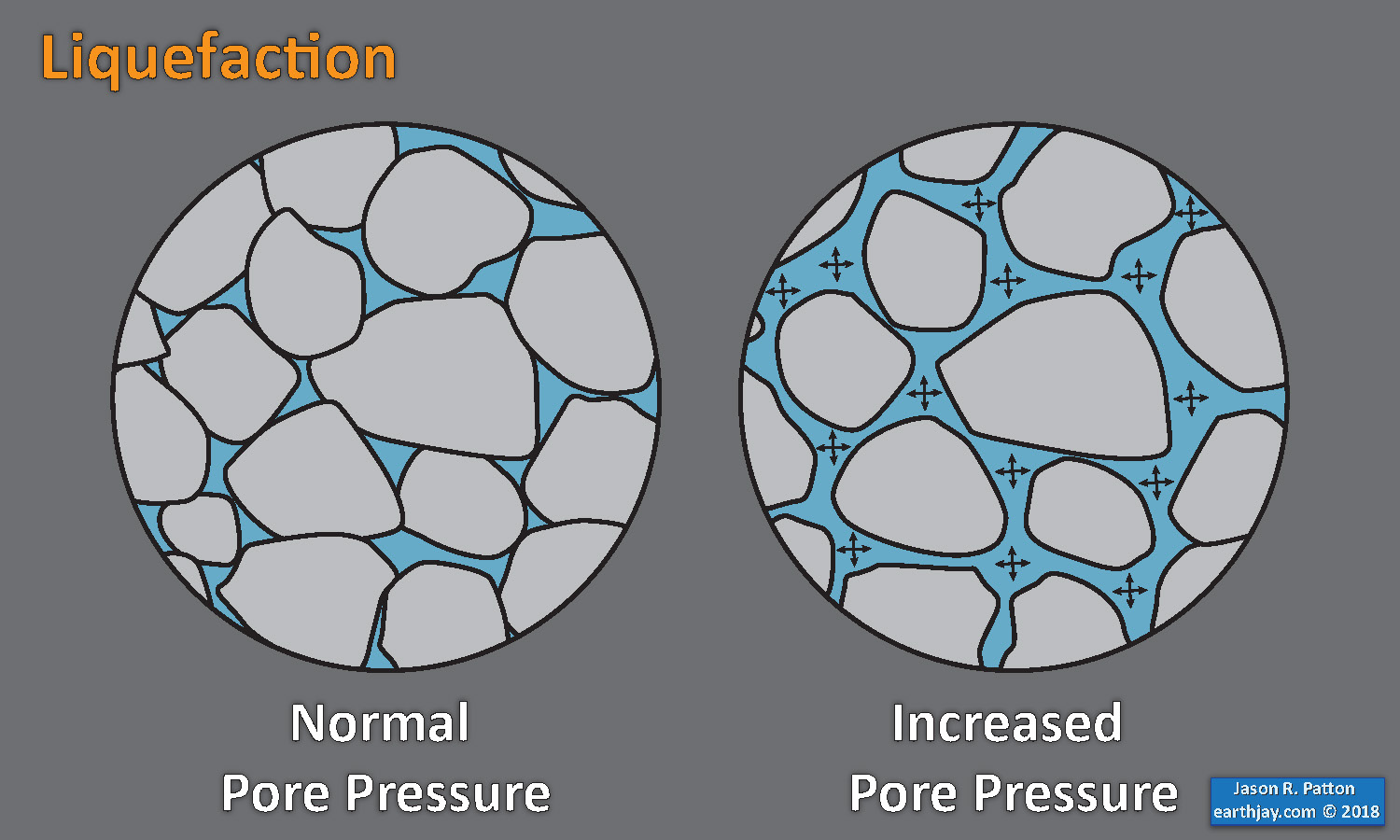
Below is a diagram based upon a publication designed to educate the public about landslides and the processes that trigger them (USGS, 2004). Additional background information about landslide types can be found in Highland et al. (2008). There was a variety of landslide types that can be observed surrounding the earthquake region. So, this illustration can help people when they observing the landscape response to the earthquake whether they are using aerial imagery, photos in newspaper or website articles, or videos on social media. Will you be able to locate a landslide scarp or the toe of a landslide? This figure shows a rotational landslide, one where the land rotates along a curvilinear failure surface.
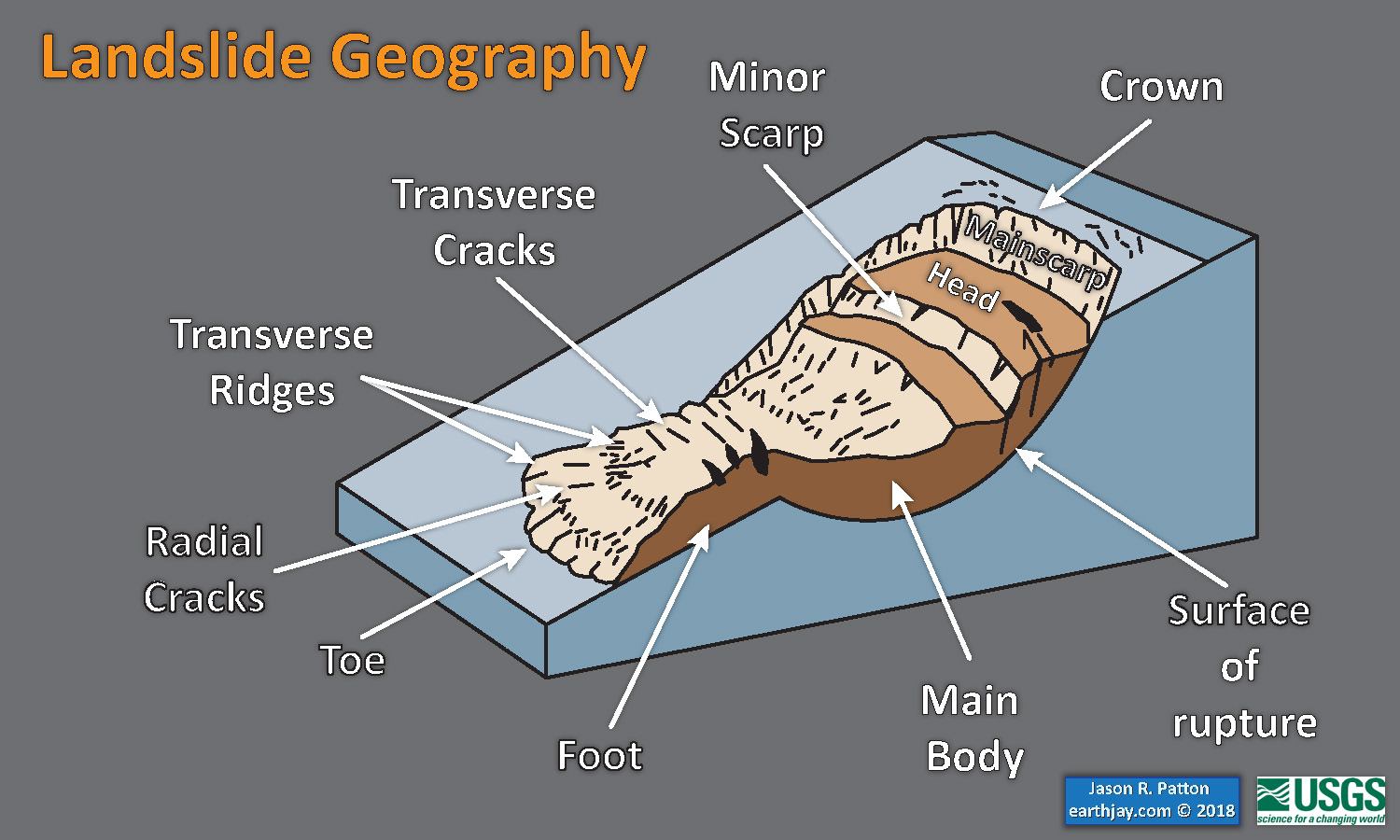
USGS Shaking Intensity
- Here is a figure that shows a more detailed comparison between the modeled intensity and the reported intensity. Both data use the same color scale, the Modified Mercalli Intensity Scale (MMI). More about this can be found here. The colors and contours on the map are results from the USGS modeled intensity. The DYFI data are plotted as colored dots (color = MMI, diameter = number of reports).
- In the upper right corner is a plot showing MMI intensity (vertical axis) relative to distance from the earthquake (horizontal axis). The models are represented by the green and orange lines. The DYFI data are plotted as light blue dots. The mean and median (different types of “average”) are plotted as orange and purple dots. Note how well the reports fit the green line (the model that represents how MMI works based on quakes in California).
- In the upper left corner is the USGS Did You Feel It reports map, showing reports as colored dots using the MMI color scale.
Other Report Pages
Some Relevant Discussion and Figures
- This is the Wouldloper (2009) tectonic map of the Mediterranean Sea.
- Here is another map of the region showing the compression in this region (Burchfiel et al., 2008 ). I include the figure caption below in blockquote.
Location of the South Balkan extensional system (SBER) withing the eastern European region. The system today is within the southern Balkan region north of the North Anatolian fault (NAF), shown by the horizontal line patter. Retreating subduction zones and related backarc extensional areas for the Mediterranean region are shown in blue , and advancing subduction zones an related are a of backarc shortening are shown in red). Backarc extensional regions are shown by dotted pattern. KF = Kefalonia fault zone.
- Here is the tectonic map from Dilek and Sandvol (2009).
Tectonic map of the Aegean and eastern Mediterranean region showing the main plate boundaries, major suture zones, fault systems and tectonic units. Thick, white arrows depict the direction and magnitude (mm a21) of plate convergence; grey arrows mark the direction of extension (Miocene–Recent). Orange and purple delineate Eurasian and African plate affinities, respectively. Key to lettering: BF, Burdur fault; CACC, Central Anatolian Crystalline Complex; DKF, Datc¸a–Kale fault (part of the SW Anatolian Shear Zone); EAFZ, East Anatolian fault zone; EF, Ecemis fault; EKP, Erzurum–Kars Plateau; IASZ, Izmir–Ankara suture zone; IPS, Intra–Pontide suture zone; ITS, Inner–Tauride suture; KF, Kefalonia fault; KOTJ, Karliova triple junction; MM, Menderes massif; MS, Marmara Sea; MTR, Maras triple junction; NAFZ, North Anatolian fault zone; OF, Ovacik fault; PSF, Pampak–Sevan fault; TF, Tutak fault; TGF, Tuzgo¨lu¨ fault; TIP, Turkish–Iranian plateau (modified from Dilek 2006).
- Below is a series of figures from Jolivet et al. (2013). These show various data sets and analyses for Greece and Turkey.
- Upper Panel (A): This is a tectonic map showing the major faults and geologic terranes in the region. The fault possibly associated with today’s earthquake is labeled OU on the map, for the Ula-Oren fault.
- Lower Panel (B): This shows historic seismicity for the region. Note the general correlation with the faults in the upper panel.
- Upper Panel (C): These red arrows are Global Positioning System (GPS) velocity vectors. The velocity scale vector is in the lower left corner. The main geodetic (study of plate motions and deformation of the earth) signal here is the westward motion of the North Anatolian fault system as it rotates southward as it traverses Greece. The motion trends almost south near the island of Crete, which is perpendicular to the subduction zone.
- Lower Panel (D): This map shows the region of mid-Cenozoic (Oligo-Miocene) extension (shaded orange). It just happens that there is still extension going on in parts of this prehistoric extension.
- Upper Panel (E): This map shows where the downgoing slab may be located (in blue), along with the volcanic centers associated with the subduction zone in the past.
- Lower Panel (F): This map shows the orientation of how seismic waves orient themselves differently in different places (anisotropy). We think seismic waves travel in ways that reflects how tectonic strain is stored in the earth. The blue lines show the direction of extension in the asthenosphere, green lines in the lithospheric mantle, and red lines for the crust.
- Upper Panel (G): This is the map showing focal mechanisms in the poster above. Note the strike slip earthquakes associated with the North Anatolian fault and the thrust/reverse mechanisms associated with the thrust faults.
A: Tectonic map of the Aegean and Anatolian region showing the main active structures
(black lines), the main sutures zones (thick violet or blue lines), the main thrusts in the Hellenides where they have not been reworked by later extension (thin blue lines), the North Cycladic Detachment (NCDS, in red) and its extension in the Simav Detachment (SD), the main metamorphic units and their contacts; AlW: Almyropotamos window; BD: Bey Daglari; CB: Cycladic Basement; CBBT: Cycladic Basement basal thrust; CBS: Cycladic Blueschists; CHSZ: Central Hellenic Shear Zone; CR: Corinth Rift; CRMC: Central Rhodope Metamorphic Complex; GT: Gavrovo–Tripolitza Nappe; KD: Kazdag dome; KeD: Kerdylion Detachment; KKD: Kesebir–Kardamos dome; KT: Kephalonia Transform Fault; LN: Lycian Nappes; LNBT: Lycian Nappes Basal Thrust; MCC: Metamorphic Core Complex; MG: Menderes Grabens; NAT: North Aegean Trough; NCDS: North Cycladic Detachment System; NSZ: Nestos Shear Zone; OlW: Olympos Window; OsW: Ossa Window; OSZ: Ören Shear Zone; Pel.: Peloponnese; ÖU: Ören Unit; PQN: Phyllite–Quartzite Nappe; SiD: Simav Detachment; SRCC: South Rhodope Core Complex; StD: Strymon Detachment; WCDS: West Cycladic Detachment System; ZD: Zaroukla Detachment. B: Seismicity. Earthquakes are taken from the USGS-NEIC database. Colour of symbols gives the depth (blue for shallow depths) and size gives the magnitude (from 4.5 to 7.6).
C: GPS velocity field with a fixed Eurasia after Reilinger et al. (2010) D: the domain affected by distributed post-orogenic extension in the Oligocene and the Miocene and the stretching lineations in the exhumed metamorphic complexes.
E: The thick blue lines illustrate the schematized position of the slab at ~150 km according to the tomographic model of Piromallo and Morelli (2003), and show the disruption of the slab at three positions and possible ages of these tears discussed in the text. Velocity anomalies are displayed in percentages with respect to the reference model sp6 (Morelli and Dziewonski, 1993). Coloured symbols represent the volcanic centres between 0 and 3 Ma after Pe-Piper and Piper (2006). F: Seismic anisotropy obtained from SKS waves (blue bars, Paul et al., 2010) and Rayleigh waves (green and orange bars, Endrun et al., 2011). See also Sandvol et al. (2003). Blue lines show the direction of stretching in the asthenosphere, green bars represent the stretching in the lithospheric mantle and orange bars in the lower crust.
G: Focal mechanisms of earthquakes over the Aegean Anatolian region.
- Here is a figure showing a north-south cross section through this region, from ~95 million years ago until about 2 million years ago (Dilek and Sandvol, 2009). This figure shows how the regional tectonics have developed over time, with the modern subduction zone in the south, the North Anatolian transform fault in the north, and an extensional metamorphic core complex in the center (“Core Complex” on cross section). Today’s earthquake is along the southern boundary of this core complex.
Late Mesozoic–Cenozoic geodynamic evolution of the western Anatolian orogenic belt as a result of collisional and extensional processes in the upper plate of north-dipping subduction zone(s) within the Tethyan realm.
- The following three figures are from Dilek et al., 2006. The locations of the cross sections are shown on the map as orange lines.
- Here is the map (Dilek et al., 2006). I include the figure caption below in blockquote.
- Here are cross sections A-D (Dilek et al., 2006). I include the figure caption for cross section D-D’ below in blockquote.
- Simplified tectonic cross-sections across various segments of the broader Alpine orogenic belt. (D) Southern Apennines–Albanides–Hellenides. Note the break where the Adriatic Sea is located between the western and eastern sections along this traverse. The Adria plate and the remnant Ionian oceanic lithosphere underlie the Apenninic-Maghrebian orogenic belt. The Alpine-Tethyan and Apulian platform units are telescoped along ENE-vergent thrust faults. The Tyrrhenian Sea opened up in the latest Miocene as a back-arc basin behind the Apenninic-Maghrebian mountain belt. The Aeolian volcanoes in the Tyrrhenian Sea represent the volcanic arc system in this subduction-collision zone environment. Modified from Lentini et al. (this volume). The eastern section of this traverse across the Albanides-Hellenides in the northern Balkan Peninsula shows a bidivergent crustal architecture, with the Jurassic Tethyan ophiolites (Mirdita ophiolites in Albania and Western Hellenic ophiolites in Greece) forming the highest tectonic nappe, resting on the Cretaceous and younger flysch deposits of the Adria affinity to the west and the Pelagonia affinity to the east. Following the emplacement of the Mirdita- Hellenic ophiolites onto the Pelagonian ribbon continent in the Early Cretaceous, the Adria plate collided with Pelagonia-Europe obliquely starting around ca. 55 Ma. WSW-directed thrusting, developed as a result of this oblique collision, has been migrating westward into the peri-Adriatic depression. Modified from Dilek et al. (2005).
Simplified tectonic map of the Mediterranean region showing the plate boundaries, collisional zones, and directions of extension and tectonic transport. Red lines A through G show the approximate profile lines for the geological traverses depicted in Figure 2. MHSZ—mid-Hungarian shear zone; MP—Moesian platform; RM—Rhodope massif; IAESZ— Izmir-Ankara-Erzincan suture zone; IPS—Intra-Pontide suture zone; ITS—inner Tauride suture zone; NAFZ—north Anatolian fault zone; KB—Kirsehir block; EKP—Erzurum-Kars plateau; TIP—Turkish-Iranian plateau.
Seismic Hazard and Seismic Risk
- As a reminder, this region is in the most seismically hazardous region of the Mediterranean. Here is the 50% probability of exceedance map (for 50 yrs) from Giardini et al. (2013).
- This morning (28 Nov, Thanksgiving here in California), I put together this figure that shows the seismic hazard and seismic risk for Europe.
- The GEM Seismic Hazard and the GEM Seismic Risk maps from Pagani et al. (2018) and Silva et al. (2018).
- I prepared a map using the USGS earthquake data products. This map shows their modeled estimate of PGA for this earthquake. Their model shows ground accelerations (shaking) greater than 50% g. This is consistent with the GEM seismic hazard map above (suggesting this area could have ground shaking between 55% and 90% g. The labels in the poster are associated with the black PGA contours, while the colors follow the legend.
- The GEM Seismic Hazard Map:
- The Global Earthquake Model (GEM) Global Seismic Hazard Map (version 2018.1) depicts the geographic distribution of the Peak Ground Acceleration (PGA) with a 10% probability of being exceeded in 50 years, computed for reference rock conditions (shear wave velocity, VS30, of 760-800 m/s). The map was created by collating maps computed using national and regional probabilistic seismic hazard models developed by various institutions and projects, and by GEM Foundation scientists. The OpenQuake engine, an open-source seismic hazard and risk calculation software developed principally by the GEM Foundation, was used to calculate the hazard values. A smoothing methodology was applied to homogenise hazard values along the model borders. The map is based on a database of hazard models described using the OpenQuake engine data format (NRML); those models originally implemented in other software formats were converted into NRML. While translating these models, various checks were performed to test the compatibility between the original results and the new results computed using the OpenQuake engine. Overall the differences between the original and translated model results are small, notwithstanding some diversity in modelling methodologies implemented in different hazard modelling software. The hashed areas in the map (e.g. Greenland) are currently not covered by a hazard model. The map and the underlying database of models are a dynamic framework, capable to incorporate newly released open models. Due to possible model limitations, regions portrayed with low hazard may still experience potentially damaging earthquakes.
- The GEM Seismic Risk Map:
- The Global Seismic Risk Map (v2018.1) presents the geographic distribution of average annual loss (USD) normalised by the average construction costs of the respective country (USD/m2) due to ground shaking in the residential, commercial and industrial building stock, considering contents, structural and non-structural components. The normalised metric allows a direct comparison of the risk between countries with widely different construction costs. It does not consider the effects of tsunamis, liquefaction, landslides, and fires following earthquakes. The loss estimates are from direct physical damage to buildings due to shaking, and thus damage to infrastructure or indirect losses due to business interruption are not included. The average annual losses are presented on a hexagonal grid, with a spacing of 0.30 x 0.34 decimal degrees (approximately 1,000 km2 at the equator). The average annual losses were computed using the event-based calculator of the OpenQuake engine, an open-source software for seismic hazard and risk analysis developed by the GEM Foundation. The seismic hazard, exposure and vulnerability models employed in these calculations were provided by national institutions, or developed within the scope of regional programs or bilateral collaborations. This global map and the underlying databases are based on best available and publicly accessible datasets and models. Due to possible model limitations, regions portrayed with low risk may still experience potentially damaging earthquakes.
- 2019.11.26 M 6.4 Albania
- 2018.10.25 M 6.8 Greece
- 2017.07.20 M 6.7 Turkey
- 2017.06.12 M 6.3 Turkey/Greece
- 2016.10.30 M 6.6 Italy
- 2016.10.30 M 6.6 Italy Update #1
- 2016.10.28 M 5.8 Tyrrhenian Sea
- 2016.10.26 M 6.1 Italy
- 2016.10.16 M 5.3 Greece/Albania
- 2016.08.23 M 6.2 Italy
- 2016.01.24 M 6.1 Mediterranean
- 2015.11.17 M 6.5 Greece
- 2015.04.16 M 6.0 Crete
Europe
General Overview
Earthquake Reports
Social Media
My Tweets are listed first (so I can easily find them later, not because they are more important).
#EarthquakeReport probably deadly and damaging shallow #earthquake in #Albania #AlbaniaEarthquake
possible #liquefaction and #landslides
USGS MMI 8
some background on tectonics here https://t.co/fFN6MH1dE5https://t.co/v2DhfiJyoK pic.twitter.com/SzhxqOlEbC
— Jason "Jay" R. Patton (@patton_cascadia) November 26, 2019
#EarthquakeReport Update to the M 6.4 #Durres #Albania #Earthquake #EarthquakeAlbania
European Database of Seismogenic Faults – 3 candidate faults – Vore, Shijak, Lushnje
Based on hypothetical max magnitudes, maybe Lushnje fault?
1979 mechanisms from Benetatos & Kiratzi, 2006 pic.twitter.com/Z6GEhzDdU1
— Jason "Jay" R. Patton (@patton_cascadia) November 27, 2019
#EarthquakeReport for the #AlbaniaEarthquake sequence in #Albania
updated report and interp poster here https://t.co/z7D9zy6ptV pic.twitter.com/zaNBTP9WKQ
— Jason "Jay" R. Patton (@patton_cascadia) November 28, 2019
#EarthquakeReport for #EarthquakeAlbania #Earthquake sequence
comparing @USGSBigQuakes model of ground shaking (PGA) with @gem_risk @gem_hazard @GEMwrld Seismic Hazard Global Earthquake Model
area could shake more strongly up to 90%g
more in report here https://t.co/z7D9zy6ptV pic.twitter.com/IraRKGkR7e
— Jason "Jay" R. Patton (@patton_cascadia) November 28, 2019
Today's #earthquake close to Tirana – Durres (Albania) has same reverse faulting mechanism than the 1979 M7.1 event whose epicenter was ~65km NW. Nodal planes of today's event are more N-S but with comparable dips.
1979 quake killed >130, left ~100000 homeless. pic.twitter.com/LEGbMB6q9v— Robin Lacassin (@RLacassin) November 26, 2019
A friend in Durrës posted photos of 5th century Byzantine era castle walls after the M6.4 #earthquake. These walls were extensively repaired in 1273 after an earthquake, and now… rescue and recovery are underway again.
Before 📸 Gerhard Përgega, after 📸 Darin Markwardt. pic.twitter.com/rWkcNjzltp
— Dr. Kasey Aderhold (@kaseyaderhold) November 26, 2019
The building shakes in #Shëngjin following the 6.4 magnitude earthquake that struck #Albania. So far, 13 residents have been killed and 600 others injured. – @LastQuake pic.twitter.com/kdWBzLq4IS
— Xhildinho Z (@xhildinho) November 26, 2019
Watch the waves from the M6.4 Albanian #earthquake roll across the USArray Transportable Array seismic network (https://t.co/RIcNz4bgWq )! pic.twitter.com/83LIQjHOkm
— IRIS Earthquake Sci (@IRIS_EPO) November 26, 2019
Map of focal mechanisms and depth in Albania from @AlexCopley_ https://t.co/w8lQVaSiNT
Today's #AlbaniaEarthquake had similar location, depth & mechanism to the 1st September 1988 earthquake pic.twitter.com/F0xiobhzF8
— Camilla Penney (@camillapenney) November 26, 2019
#ERCC #DailyMap: 2019-11-26 ⦙ Albania | 6.4M Earthquake ▸https://t.co/4UCZ11KWvl ⦙ via @EU_ECHO #EUCivPro pic.twitter.com/3odLY7FmzS
— Copernicus EMS (@CopernicusEMS) November 26, 2019
🔴#ALBANIA🇦🇱: A drone captures a video from the heights of the massive destruction caused by the earthquake in the city of #Thumanë, in the district of #Krujë. Stay safe.
Video: @IgliLime.#EQVT,#tërmet,#terremoto,#earthquake,#PrayForAlbania,#AlbaniaEarthquake,#EarthquakeAlbania. pic.twitter.com/pNURbExTkk— American Earthquakes 🌋🌊🌎 (@earthquakevt) November 26, 2019
3D view of the co-seismic deformation from the Mw6.4 Durres, Albania #earthquake. #Sentinel1 interferogram overlay and ALOS GDSM elevation. Ifg processed w/DIAPASON at @esa_gep. Each color fringe represents ~2.8cm of surface displacement relative to the satellite. pic.twitter.com/OMpaB7ky5J
— Sotiris Valkaniotis (@SotisValkan) November 27, 2019
Full 3D view of the Mw6.5 #Durres earthquake interferogram along the ascending orbit processed with @esa_gep. @mrBig973 @SimoneAtzori73 @INGVterremoti pic.twitter.com/D40gvpa0dD
— Matteo Albano 🌍🏗️ (@matteo_albano) November 27, 2019
UPDATE 2019.11.28
(Very…) first crude model of the Mw6.4 Durres, Albania #earthquake fault rupture plane, using #InSAR results. Deep low-angle thrust, dipping northeast – USGS/GFZ hypocenters close to rupture plane. 3D view using Qgis & Threejs. pic.twitter.com/IocR3Mn1rs
— Sotiris Valkaniotis (@SotisValkan) November 27, 2019
Aggiornamento terremoto Mw 6.2 del 26 novembre 2019 in Albania https://t.co/iiM8OK95kU
— ingv presidente (@ingv_president) November 27, 2019
— Andrew Schaeffer (@schaefferaj) November 28, 2019
UPDATE 2019.12.01
Descending interferogram (19-11-19/01-12-19) of the Mw 6.4 #Durres, #Albania earthquake, processed with @esa_gep. @SimoneAtzori73 @mrBig973 @INGVterremoti @VDN75 pic.twitter.com/iBQ6LPdP6v
— Matteo Albano 🌍🏗️ (@matteo_albano) December 1, 2019
Urban growth of Durrës/Δυρράχιο, Albania during the last 55 years; satellite imagery comparison from 1965 & today shows rapid expansion towards the inner alluvial floodplain and the coastal sand dune system to the southeast. pic.twitter.com/cakhmMKw5Z
— Sotiris Valkaniotis (@SotisValkan) December 1, 2019
Another fault slip model for the #Durres #earthquake that involves Vora Backthrust fault plane source by #GreDaSS and #sentine1 by @esa @CopernicusEU data.
Epicenter by @GFZ_Potsdam.
Good fit.@FraxInSAR @SimoneAtzori73 @otreborilisab @matteo_albano @USGSBigQuakes @SotisValkan pic.twitter.com/mNwz99LWAW— Vincenzo De Novellis (@VDN75) December 2, 2019
UPDATE 2020.11.08
— Jason "Jay" R. Patton (@patton_cascadia) January 8, 2020
- Frisch, W., Meschede, M., Blakey, R., 2011. Plate Tectonics, Springer-Verlag, London, 213 pp.
- Hayes, G., 2018, Slab2 – A Comprehensive Subduction Zone Geometry Model: U.S. Geological Survey data release, https://doi.org/10.5066/F7PV6JNV.
- Holt, W. E., C. Kreemer, A. J. Haines, L. Estey, C. Meertens, G. Blewitt, and D. Lavallee (2005), Project helps constrain continental dynamics and seismic hazards, Eos Trans. AGU, 86(41), 383–387, , https://doi.org/10.1029/2005EO410002. /li>
- Jessee, M.A.N., Hamburger, M. W., Allstadt, K., Wald, D. J., Robeson, S. M., Tanyas, H., et al. (2018). A global empirical model for near-real-time assessment of seismically induced landslides. Journal of Geophysical Research: Earth Surface, 123, 1835–1859. https://doi.org/10.1029/2017JF004494
- Kreemer, C., J. Haines, W. Holt, G. Blewitt, and D. Lavallee (2000), On the determination of a global strain rate model, Geophys. J. Int., 52(10), 765–770.
- Kreemer, C., W. E. Holt, and A. J. Haines (2003), An integrated global model of present-day plate motions and plate boundary deformation, Geophys. J. Int., 154(1), 8–34, , https://doi.org/10.1046/j.1365-246X.2003.01917.x.
- Kreemer, C., G. Blewitt, E.C. Klein, 2014. A geodetic plate motion and Global Strain Rate Model in Geochemistry, Geophysics, Geosystems, v. 15, p. 3849-3889, https://doi.org/10.1002/2014GC005407.
- Meyer, B., Saltus, R., Chulliat, a., 2017. EMAG2: Earth Magnetic Anomaly Grid (2-arc-minute resolution) Version 3. National Centers for Environmental Information, NOAA. Model. https://doi.org/10.7289/V5H70CVX
- Müller, R.D., Sdrolias, M., Gaina, C. and Roest, W.R., 2008, Age spreading rates and spreading asymmetry of the world’s ocean crust in Geochemistry, Geophysics, Geosystems, 9, Q04006, https://doi.org/10.1029/2007GC001743
- Pagani,M. , J. Garcia-Pelaez, R. Gee, K. Johnson, V. Poggi, R. Styron, G. Weatherill, M. Simionato, D. Viganò, L. Danciu, D. Monelli (2018). Global Earthquake Model (GEM) Seismic Hazard Map (version 2018.1 – December 2018), DOI: 10.13117/GEM-GLOBAL-SEISMIC-HAZARD-MAP-2018.1
- Silva, V ., D Amo-Oduro, A Calderon, J Dabbeek, V Despotaki, L Martins, A Rao, M Simionato, D Viganò, C Yepes, A Acevedo, N Horspool, H Crowley, K Jaiswal, M Journeay, M Pittore, 2018. Global Earthquake Model (GEM) Seismic Risk Map (version 2018.1). https://doi.org/10.13117/GEM-GLOBAL-SEISMIC-RISK-MAP-2018.1
- Zhu, J., Baise, L. G., Thompson, E. M., 2017, An Updated Geospatial Liquefaction Model for Global Application, Bulletin of the Seismological Society of America, 107, p 1365-1385, https://doi.org/0.1785/0120160198
- Benetatos, C., Kiratzi, A., 2006. Finite-fault slip models for the 15 April 1979 (Mw 7.1) Montenegro
earthquake and its strongest aftershock of 24 May 1979 (Mw 6.2) in Tectonophysics, v. 421, p. 129-143, http://dx.doi.org/10.1016/j.tecto.2006.04.009 - Burchfiel, B.C., et al., 2008. Evolution and dynamics of the Cenozoic tectonics of the South Balkan extensional system in Geosphere, v. 4, p. 919-938.
- Dilek, Y., 2006. Collision tectonics of the Mediterranean region: Causes and consequences in Dilek, Y., and Pavlides, S., eds., Postcollisional tectonics and magmatism in the Mediterranean region and Asia: Geological Society of America Special Paper 409, p. 1–13
- Dilek, Y. and Sandvol, E., 2006. Collision tectonics of the Mediterranean region: Causes and consequences in Dilek, Y., and Pavlides, S., eds., Postcollisional tectonics and magmatism in the Mediterranean region and Asia: Geological Society of America Special Paper 409, p. 1–13
- DISS Working Group (2015). Database of Individual Seismogenic Sources (DISS), Version 3.2.0: A compilation of potential sources for earthquakes larger than M 5.5 in Italy and surrounding areas. http://diss.rm.ingv.it/diss/, Istituto Nazionale di Geofisica e Vulcanologia; DOI:10.6092/INGV.IT-DISS3.2.0.
- Ganas, A., and T. Parsons (2009), Three-dimensional model of Hellenic Arc deformation and origin of the Cretan uplift, J. Geophys. Res., 114, B06404, doi:10.1029/2008JB005599
- Ganas, A., Oikonomou, I.A., and Tsimi, C., 2013. NOAFAULTS: A Digital Database for Active Faults in Greece in Bulletin of the Geological Society of Greece, v. XLVII, Proceedings of the 13th International Congress, Chania, Sept, 2013
- Jolivet, L., et al., 2013. Aegean tectonics: Strain localisation, slab tearing and trench retreat in Tectonophysics, v. 597-598, p. 1-33
- Kokkalas, S., et al., 2006. Postcollisional contractional and extensional deformation in the Aegean region in GSA Special Papers, v. 409, p. 97-123.
- Picha, F. J., 2002. Late Orogenic Strike-Slip Faulting and Escape Tectonics in Frontal Dinarides-Hellenides, Croatia, Yugoslavia, Albania, and Greece, AAPG Bull., v. 86, p. 1659–1671.
- Taymaz, T., Yilmaz, Y., and Dilek, Y., 2007. The geodynamics of the Aegean and Anatolia: introduction in Geological Society Special Publications, v. 291, p. 1-16.
- Woudloper, 2009. Tectonic map of southern Europe and the Middle East, showing tectonic structures of the western Alpide mountain belt. Only Alpine (tertiary) structures are shown.
References:
Basic & General References
Specific References
Return to the Earthquake Reports page.
